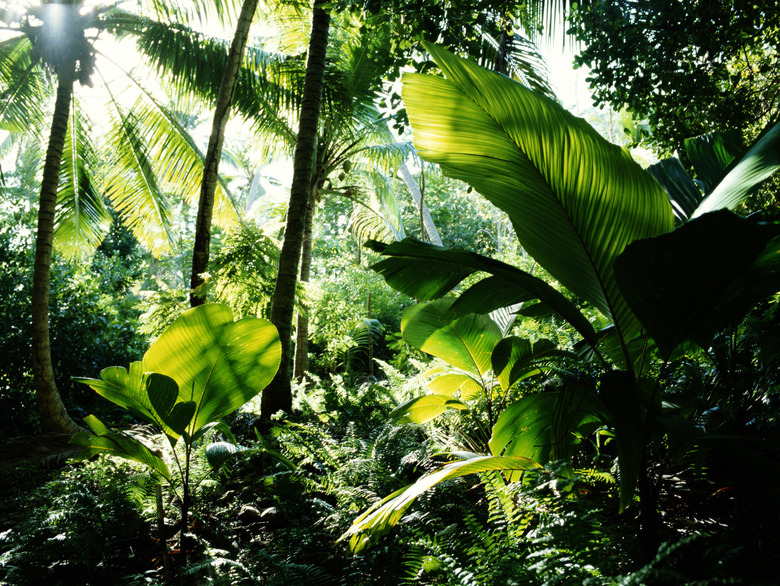The Trophic Levels In Rain Forests
In any ecosystem, life and energy flows in a pyramid. Trophic levels in rainforests are similar to those in other ecosystems. Organisms known as producers create energy, and that energy results in a trophic effect through the rainforest food web. Other animals feed on those producers and acquire the energy, and those creatures fall prey to other organisms higher in the food chain.
The Trophic Levels in Rainforests
The Trophic Levels in Rainforests
Like all systems, the trophic levels in rainforests start at the producers, who create energy, and move up through the consumers, who utilize that energy. Plants make up the majority of producers. In the rainforest energy pyramid, the producers are the most numerous, and thus make up the base of the pyramid.
The next level of the pyramid is the primary consumers. Primary consumers feed upon the producers, and because they rely upon the number of producers available, they are not as numerous. These are the herbivores, prey species to the secondary consumers.
Secondary consumers have even fewer numbers than primary consumers because they rely upon trophic levels below them. The same applies to the final trophic level, the tertiary consumers. Secondary and tertiary consumers are the omnivores and carnivores in an ecosystem. However, the trophic effect doesn't always move consecutively. For example, secondary consumers might feed upon primary consumers but also feed directly upon producers as well.
Producers in the Rainforest
Producers in the Rainforest
In a tropical rainforest energy pyramid, animals rely on many different producers, including the plants themselves and the fruit that they bear. Some important producers in the Amazon rainforest include bananas, Brazil nuts, jackfruit, mango, figs and many other plants. Primary consumers often rely heavily upon the fruiting season of specific trees for survival at various times of year.
All producers create energy from water, carbon dioxide and sunlight by using photosynthesis. They support the entire food web and are the most numerous because they do not rely on any other trophic levels for survival.
Primary Consumers in the Rainforest
Primary Consumers in the Rainforest
The next level in the trophic effect is the primary consumer. Primary consumers are the herbivores in an ecosystem, or the animals that feed upon the plants. Some examples of primary consumers in the rainforest energy pyramid are agoutis, iguanas, tapirs, capybaras, sloths and deer. Many insects, such as caterpillars, butterflies and grasshoppers also fall under the primary consumer trophic level.
Primary consumers rely on the energy created by producers to survive. They are less numerous than producers, but more numerous than any other consumer. Other consumers are limited in population by the volume of primary consumers in an ecosystem.
Secondary Consumers in the Rainforest
Secondary Consumers in the Rainforest
The next trophic level of the rainforest is the secondary consumer. These creatures are carnivores or omnivores that feed upon the primary consumers and sometimes the producers as well. Some examples of secondary consumers in the Amazon rainforest include the boa constrictor and other snakes, monkeys and tamarins, toucans, and other omnivorous or predatory birds.
Populations of producers and primary consumers directly impact the volume of secondary consumers that can survive in an ecosystem. Members of this group often prey on primary consumers, but also fall prey to apex predators as well. For example, spider monkeys (secondary consumer) might feed on fruits and nuts (producer) as well as insects and bird eggs (primary consumer), but they also fall prey to harpy eagles (tertiary consumer).
Tertiary Consumers in the Rainforest: Apex Predators
Tertiary Consumers in the Rainforest: Apex Predators
Tertiary consumers sit atop the rainforest energy pyramid. They feed upon both primary and secondary consumers, and researchers often consider them apex predators. Some examples of tertiary consumers in the Amazon rainforest include harpy eagles, jaguars, caimans and anacondas. Though they feed mostly upon other consumers, these predators do sometimes hunt other tertiary predators. For example, scientists have recorded jaguars hunting caimans!
At the top of the rainforest energy flow, tertiary consumers have the most limited populations. They rely fully upon the numbers of the consumers beneath them in the pyramid. For example, the jaguar trophic level relies upon the populations of capybara, tapir, monkey and other lower consumers.
References
Cite This Article
MLA
Zinni, Yasmin. "The Trophic Levels In Rain Forests" sciencing.com, https://www.sciencing.com/trophic-levels-rain-forests-8732158/. 30 September 2021.
APA
Zinni, Yasmin. (2021, September 30). The Trophic Levels In Rain Forests. sciencing.com. Retrieved from https://www.sciencing.com/trophic-levels-rain-forests-8732158/
Chicago
Zinni, Yasmin. The Trophic Levels In Rain Forests last modified August 30, 2022. https://www.sciencing.com/trophic-levels-rain-forests-8732158/
